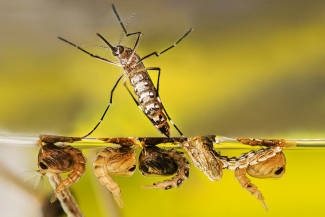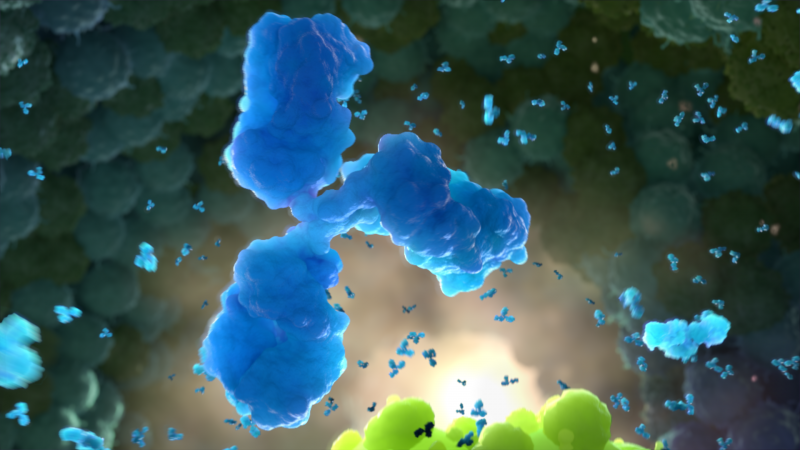Spotlight on: The risk of infectious diseases in a changing world

Human activity, for better or worse, has had a massive effect on the world around us. From human settlements encroaching on previously untouched wilderness to destruction of native habitats to altering the very climate of the planet, human industry has changed the environment. The ripple effects of these changes can be witnessed in both subtle and colossal ways.
Alongside the effects that many might think of, such as loss of animal habitats, property damage, and human injury or death at the hands of natural disasters, another, less commonly considered, issue also requires our collective attention — the increased spread of infectious diseases. This article will take a look at the ways in which changes in the environment can impact the origin and spread of infectious diseases, provide some examples, and describe some ways that these dangers can be mitigated.
All creatures strive to survive
Infectious agents circulating in a population (such as viruses, bacteria, or parasites) will generally reach a sort of equilibrium with their hosts, meaning that pathogens will evolve as needed to avoid extinction, while their hosts will develop immunity to prevent the pathogen from killing the population at large. Thankfully as human beings, we’re able to alter this equilibrium to our benefit by leveraging medical treatments and disease control programs. However, this equilibrium can also be shifted by unforeseen changes to the environment in which the pathogen and host exist.
In the face of a changing environment, all organisms (i.e., hosts and pathogens) are forced to adapt to new circumstances. The alternative to adaptation is extinction, an untenable outcome for any organism. When any creature adapts to a new or changed environment, they may encounter new risks or opportunities. These environmental changes can impact infectious diseases. For example, pathogens may come into contact with new hosts that they previously did not encounter or they may more frequently pass between established hosts, allowing for more infections than previously witnessed. Let’s take a look at a few examples related to human pathogens and how their transmission has been affected by changes in the environment.
Close contact
Most infectious diseases that are “new” to the human population are actually caused by pathogens that already existed outside of human populations, circulating quietly in nonhuman hosts. The coronavirus that caused the COVID-19 pandemic, called SARS-CoV-2, is one such example.
It is highly likely that the disruption of bat habitats in China contributed to the mutation that allowed SARS-CoV-2 to infect other animals, including human beings. It’s been found that bats will congregate more closely together due to loss of their native forest habitat. When these conditions arise, viruses can quickly spread from animal to animal, mutating as they encounter the differences between each animal’s immune system. Likewise, if the animals experience a loss in usable territory due to climate change, natural disasters, or human-driven destruction of habitats, the population of animals will need to travel to new areas looking for food, water, and shelter. This can result in different groups of animals spending more time in closer contact or more types of animals moving into manmade environments. As these new species cohabitate in an area, the pathogens that infect them may find their way into other hosts, humans included; this is a phenomenon known as spillover.
Spillover
While any encounter between a human and a wild animal has the opportunity to introduce a pathogen to the person, such transmission events rarely result in illness and even more rarely result in an infection that can also spread from one person to another. This is because most pathogenic organisms infect a specific species and cannot survive in a new host.
Sometimes, however, an animal pathogen will develop a genetic mutation that allows it to readily infect other hosts, like humans. While random genetic mutations are common, random mutations that result in the kind of change that enables the pathogen to infect new hosts are not. To be self-sustaining, spillover events typically require an accumulation of mutations that enable the pathogen to reproduce more effectively in the new host, evade host defenses, and spread within the new host population. (See “A Closer Look: How Viruses Evolve Over Time” in the resources section).
For example, the orthopoxvirus family includes a group of genetically related viruses that infect a wide range of mammalian hosts. Before its eradication, smallpox infected people and spread easily among them, killing about 1 of every 3 people it infected. However, other orthopoxviruses have also spread from animals and infected people. Indeed, cowpox was used to help eradicate smallpox when Edward Jenner realized that milkmaids, a group often infected with the less dangerous cowpox, were protected during smallpox outbreaks. More recently, mpox (formerly known as monkeypox) and a newly discovered orthopoxvirus, called Alaskapox, have been infecting people in addition to their non-human hosts. While neither of these are as fatal as smallpox, both have gained the ability to infect individuals and cause illness, but (to date) only mpox has evolved to spread from person to person. Alaskapox was responsible for its first fatal infection in February of 2024. Scientists will continue to monitor Alaskapox for additional changes that could allow it to spread among people in the future.
Longer seasons, larger regions
While many pathogens are transmitted directly from one infected individual to another, some can be transmitted from person to person by intermediate carrier organisms, referred to as vectors. These pathogens infect people when the vector, such as a tick or mosquito, bites someone and introduces the pathogen to their system. For example, this is how ticks spread Lyme disease and how mosquitoes spread malaria. Just as with other animals, disease vectors respond to environmental changes by adapting – and sometimes these responses also alter the spread of diseases.
Because organisms that serve as vectors are exclusively invertebrates, such as insects, their migration and reproduction are very sensitive to climate conditions, like temperature. For example, mosquitoes are vectors for over a dozen disease-causing pathogens, including those that cause malaria, dengue, yellow fever, and Zika virus disease. Mosquitoes thrive in warm, humid environments, like those found around the tropics, and while they might visit colder climates, lower temperatures curb their ability to breed, limiting the spread of diseases they carry in seasonal climates. Unfortunately, as carbon emissions warm the earth, breeding seasons are getting longer and the regions where mosquitoes are present year-round are expanding. For example, in the fall of 2023, an unusual number of locally acquired cases of malaria were reported in the U.S., and tickborne illnesses, like Lyme disease, have emerged in new parts of North America and Europe. Indeed, the yearly count of diseases related to tick bites in the U.S has more than doubled in the past 20 years.
What can be done?
As the world around us changes, all creatures that share the planet must, by necessity, adapt to survive, but humans can do things to remain abreast of this situation and combat infectious diseases:
- Invest in disease surveillance globally, so that we can catch the next spillover event before it explodes into a pandemic. This can be accomplished by regular testing for emerging pathogens, not only in people, but also in domesticated and wild animals with which we might come into contact.
- Similarly, it will be crucial to maintain ongoing surveillance and control of disease vectors. By tracking the spread of vector organisms, we can better prepare for and control both the vectors and the diseases they spread. For example, attempts to control vector numbers to reduce or eliminate particular vector-borne diseases are ongoing. Even though many of these initiatives come from large organizations, such as governments and academic institutions, individuals can contribute to these efforts through “citizen science” crowdsourcing projects, such as mapping mosquito habitats or tracking seasonal changes that could affect vector populations. Check out the citizen science websites in the “Related resources” section of this article to explore project options.
- Prepare for new diseases before they arise. By researching and developing novel strategies, such as new treatments and preventions, we will be better positioned for rapid responses when new infections emerge. Such efforts proved enormously helpful in the rapid deployment of mRNA vaccines during the COVID-19 pandemic.
- Of course, we must also address the root causes of some of the widespread environmental changes that are contributing to this situation. Implementation of reforestation, conservation, and waste cleanup initiatives are vital to the repair of damaged habitats around the world. Pivoting to clean energy sources will also allow us to slow the progression of the climate crisis, and investing in the development of carbon capture mechanisms may also help restore the health of our planet.
Related resources
A Closer Look: How Viruses Change Over Time (article)
Six things you need to know about Alaskapox virus (article)
As Temperatures Rise, Dengue Fever Spreads and Cases Rise (article)
Locally Acquired Cases of Malaria in Florida, Texas, Maryland, and Arkansas (article)
Tickborne Diseases Are on the Rise—Here’s What To Know (article)
Our Risk For Infectious Diseases Is Increasing Because of Climate Change (webpage)
What is the link between climate change and infectious disease? (webpage)
SciStarter citizen science hub (website)
CitizenScience.gov (website)

